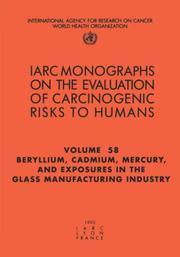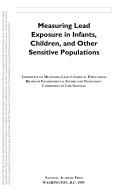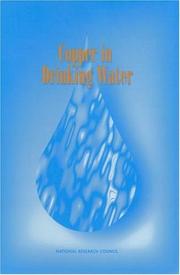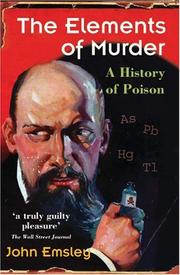| Listing 1 - 10 of 39 | << page >> |
Sort by
|
Book
Year: 2001 Publisher: Bruxelles: UCL,
Abstract | Keywords | Export | Availability | Bookmark
 Loading...
Loading...Choose an application
- Reference Manager
- EndNote
- RefWorks (Direct export to RefWorks)
In this study, we compared the body burden (in serum fat) of dioxins (PCDD/Fs), the concentrations of three heavy metals (lead in blood, mercury in urine, cadmium in urine), and the concentrations of serum CC16 in subjects living near two municipal solid waste incinerators (MSWI) in Wallonia (Belgium) with that controls living in an unpolluted rural area.
A total of 85 subjects were recruited around the two MSWIs, 52 from a rural area (Thumaide 26 women and 26 men, aged 21 to 80 years) and 33 from Pont-au-Loup an industrial area (20 women and 17 men, aged 33 to 65). These subjects were compared with 27 control subjects (11 women and 16 men, aged 33 to 66) living in the Ardennes (Belgium). These groups were not significantly different with respect to age, gender, smoking habits and health status. Dioxins were quantified by GCMS, the heavy metals by atomic absorption spectrometry and the CC16 by latex immuno assay (LIA).
the dioxin body burden of residents near the Thumaide MSWI was significantly higher than that of the control subjects living on the Ardennes (36.7 va 27.2 pg TEQ/g fat, p = 0.01). By contrast, the dioxin body burden of subjects living near the Pont-au-Loup MSWI (24.3 pg TEQ/g fat) was slightly (but nor significantly) lower than that of the control. This difference between Thumaide and Pont-au-Loup is most probably due to the lower proportions of residents regularly consuming locally produced foods in Pont-au-Loup (27%) compared to Thumaide (50%).
The mean blood lead concentrations in the residents near the two MSWIs (Thumaide: 42.08 μg/L; Pont-au-Loup: 42.48 μg/L), was not significantly different from that in the control group (53.82 μg/L). The means concentrations of cadmium in urine in the Thumaide residents (0.57 μg/g creatinine) and in the Pont-au-Loup subjects (0.44 μg/g creatinine) were also significantly different compared to the control values (0.49 μg/g creatinine).
for the mercury concentration in urine, a significant difference was found between the subjects from Pont-au-Loup and the control group (2.24 vs 1.56 μg/g creatinine). But this difference not found in Thumaide (1.77 vs 1.56 μg/g creatinine), could be related to dental fillings.
We did not found any significant difference between the two exposed groups and controls for the serum concentration of CC16 (Thumaide: 8.41 vs 9.07 μg/L; Pont-au-Loup 8.42 vs 9.07 μg/L).
In conclusion, the emissions of the MSWIs do not appear to increase the concentrations of heavy metals and to induce change in serum CC16. However, the body burden of dioxins in the people from the Thumaide area was found 34% higher compared to the people living in the Ardenne. Dans cette étude, nous avons comparé la charge corporelle des dioxines (PCDD/Fs) dans la fraction lipidique du sérum, le taux de trois métaux lourds (le plomb sanguin, le mercure et le cadmium urinaire) ainsi que la concentration de CC16 sérique d’individus exposés aux émissions de deux incinérateurs de déchets ménagers par rapport à un groupe témoin qui vit dans un milieu rural non pollué.
Nous avons recruté 85 personnes vivant près des deux incinérateurs, 52 personnes sont originaires de la région de Thumaide (26 hommes et 26 femmes dont l’âge varie entre 21 et 80 ans), tandis que 33 personnes proviennent de la région de Pont-de-loup (17 hommes et 20 femmes dont l’âge varie entre 33 et 65 ans). Ces individus ont été comparés avec un groupe contrôle vivant en Ardenne (16 hommes et 11 femmes dont l’âge varie entre 33 et 66 ans). Un test de comparaison entre les différents groupes nous a permis de constater que ceux-ci ne diffèrent pas significativement en ce qui concerne l’âge, le sexe, les habitudes tabagiques et la fréquence des maladies chroniques.
la charge corporelle en dioxines des riverains de l’incinérateur de Thumaide était significativement augmentée par rapport au groupe contrôle (36.7 vs 27.7 pg TEQ/s lipides, p = 0.01). Par contre la charge corporelle des riverains de l’incinérateur de Pont-au-Loup n’était pas significativement différente par rapport au groupe témoin (24.3 pg TEQ /g lipides). Cette différence entre Thumaire et Pont-au-Loup est très probablement expliquée par la plus faible proportion d’individus qui consomment des produits locaux 27% à Pont-au-Loup contre 50% à Thumaide.
La plombémie des riverains des deux incinérateurs (Thumaide : 42.8 μg/L ; Pont-de-Loup : 42.48 μg/L) n’est pas significativement différente de celle du groupe témoin (53.82 μg/L). Aucune différence significative n’ pas être mise en évidence entre les riverains des deux incinérateurs (Thumaide : 0.57 μg/g créatinine ; Pont-au-Loup : 0.44 μg/g créatinine) en ce qui concerne le cadmium urinaire.
La concentration en mercure urinaire est significativement plus élevée chez les riverains de l’incinérateur de Pont-au-Loup comparativement au taux de mercure au sein du groupe témoin (2.24 vs 1.56 μg/g créatinine). Mais cette différence qui ne se retrouve pas à Thumaide (1.77 vs 1.56 μg/g créatinine), pourrait être expliquée par la présence d’un plus grand nombre d’amalgames dentaires.
Aucune différence significative n’ pas être mise en évidence entre les deux groupes exposés et le groupe témoin en ce qui concerne le taux de CC16 sérique.
En conclusion, les émissions des incinérateurs ne semblent pas augmenter la concentration en métaux lourds, et n’induiraient pas de changement au niveau de la concentration de la CC16 sérique. Toutefois, la charge corporelle en dioxines des riverains de l’incinérateur de Thumaide est augmentée de 34 % en comparaison avec le groupe contrôle
Air Pollution --- Environmental Exposure --- Dioxins --- Metals, Heavy
Book
ISBN: 0323856217 0323885500 Year: 2022 Publisher: Amsterdam, Netherlands : Elsevier,
Abstract | Keywords | Export | Availability | Bookmark
 Loading...
Loading...Choose an application
- Reference Manager
- EndNote
- RefWorks (Direct export to RefWorks)
"Heavy metal pollution is a serious threat to living organisms. Industrial development has aggravated multifaceted problems in the environment requiring a comprehensive solution. Appraisal of Metal(loids) in the Ecosystem addresses this need and provides a basic introduction of different heavy metals. Presented in a consistent and comprehensive manner, each chapter highlights the background level, occurrence, speciation, bioavailability, uptake detoxification mechanisms, and management of each metal in polluted soils. It provides the latest up-to-date information about different aspects of As, Hg, Si, Cu, Co, Ni, Mn, Cd, Cr, etc. in single source."--
Heavy metals --- Environmental aspects. --- Physiological effect. --- Metals, Heavy --- Soil Pollutants --- toxicity
Book
ISBN: 9781845934026 1845934024 Year: 2008 Publisher: Wallinford : CABI,
Abstract | Keywords | Export | Availability | Bookmark
 Loading...
Loading...Choose an application
- Reference Manager
- EndNote
- RefWorks (Direct export to RefWorks)
Plant physiology --- membranes --- Vacuoles --- plant nutrition --- Storage organs --- Plant cell membranes --- Plant translocation --- Calcium --- Iron --- Manganese --- Membrane transport proteins --- Metals, heavy --- Nitrogen --- Photosynthesis --- Plants --- Potassium --- Silicon --- Sulfates
Book
ISBN: 9789086860616 Year: 2008 Publisher: Wageningen, Netherlands : Wageningen Academic Publishers,
Abstract | Keywords | Export | Availability | Bookmark
 Loading...
Loading...Choose an application
- Reference Manager
- EndNote
- RefWorks (Direct export to RefWorks)
Trace elements in animal nutrition --- 633.3 --- detectie (lt) --- opfok (lt) --- residu (lt) --- traceerbaarheid (lt) --- veehouderij(lt) --- veevoeding (lt) --- Animal Feed. --- Animal Feed --- Metals, heavy --- Trace elements
Book
ISBN: 0323902162 0323899765 9780323902168 9780323899765 Year: 2022 Publisher: London, England : Academic Press,
Abstract | Keywords | Export | Availability | Bookmark
 Loading...
Loading...Choose an application
- Reference Manager
- EndNote
- RefWorks (Direct export to RefWorks)
"Clinical Signs in Humans and Animals Associated with Minerals, Trace Elements and Rare Earth Elements is the first book to compile the clinical signs associated with deficiencies, toxicities, imbalances, exposures to minerals, trace elements and rare earth elements in animals. This book aims to increase awareness to improve diagnosis and to encourage further investigation based on comparative data. Written by an experienced veterinary clinician having worked in private practice, academia, pharmaceutical and pet food industries, this book includes data on companion animals, horses, rabbits, reptiles, ruminants, poultry, fish, and species typical in zoo populations. In addition, the book touches upon human and other primate data. The subject material is divided into three sections to provide easy access to information on clinical signs, specific elements, or species. This is an ideal resource for veterinary researchers, clinicians and practitioners, specifically those working with animal nutrition and animal feed health. Academics and public health scientists will also benefit from this book's information and data on rehabilitating and maintaining animal health"-- |c Provided by publisher.
Minerals in animal nutrition. --- Feeds --- Animal nutrition --- Mineral content --- Trace Elements --- Metals, Heavy --- Phosphorus --- Transition Elements --- Metalloids --- Elements --- Occupational Exposure --- Chemically-Induced Disorders --- Poisoning --- Animals --- Humans --- Oligoéléments. --- Éléments (chimie) --- Métaux. --- Intoxication. --- Risques professionnels --- Chez les animaux --- Trace Elements. --- Occupational Exposure. --- Poisoning. --- Animals. --- Humans. --- Metals, Heavy. --- Phosphorus. --- Transition Elements. --- Metalloids. --- Elements. --- Chemically-Induced Disorders.

ISBN: 9283212584 Year: 1993 Volume: 58 Publisher: [Place of publication not identified] IARC World Health Organization
Abstract | Keywords | Export | Availability | Bookmark
 Loading...
Loading...Choose an application
- Reference Manager
- EndNote
- RefWorks (Direct export to RefWorks)
Oncology. Neoplasms --- Toxicology --- Beryllium --- Cadmium --- Occupational Exposure --- Mercury --- Carcinogens --- Metals, Alkaline Earth --- Transition Elements --- Metals, Light --- Metals, Heavy --- Noxae --- Environmental Exposure --- Metals --- Environmental Pollution --- Toxic Actions --- Elements --- Inorganic Chemicals --- Public Health --- Chemical Actions and Uses --- Chemicals and Drugs --- Environment and Public Health --- Health Care --- Conferences - Meetings --- NEOPLASMS --- RISK FACTORS --- OCCUPATIONAL EXPOSURE --- GLASS --- INDUSTRY --- WORLD HEALTH ORGANIZATION --- ETIOLOGY

ISBN: 030904927X 9786610196135 1280196130 0309598419 0585077053 9780585077055 9780309049276 9780309598415 Year: 1993 Publisher: Washington, D.C. : National Academy Press,
Abstract | Keywords | Export | Availability | Bookmark
 Loading...
Loading...Choose an application
- Reference Manager
- EndNote
- RefWorks (Direct export to RefWorks)
MEDICAL --- Physiology --- Lead --- Lead poisoning in children --- Infant --- Lead Poisoning --- Child --- Metals, Heavy --- Age Groups --- Poisoning --- Persons --- Elements --- Substance-Related Disorders --- Metals --- Named Groups --- Inorganic Chemicals --- Diseases --- Chemicals and Drugs --- Toxicology & Public Health --- Public Health --- Health & Biological Sciences --- Toxicology --- Lead poisoning in children. --- Toxicology. --- Childhood lead poisoning --- Pediatric toxicology

ISBN: 0309069394 9786610185559 1280185554 0309594065 0585256381 9780585256382 6610185557 9780309069397 0309172209 Year: 2000 Publisher: Washington, D.C. : National Academy Press,
Abstract | Keywords | Export | Availability | Bookmark
 Loading...
Loading...Choose an application
- Reference Manager
- EndNote
- RefWorks (Direct export to RefWorks)
Water - Copper content. --- Copper --- Water --- Metals, Heavy --- Sanitary Engineering --- Environmental Pollution --- Transition Elements --- Public Health --- Elements --- Sanitation --- Metals --- Inorganic Chemicals --- Environment and Public Health --- Chemicals and Drugs --- Health Care --- Water Supply --- Environmental Exposure --- Health & Biological Sciences --- Toxicology & Public Health --- Toxicology --- Copper content --- Disorders --- Metabolism --- Toxicology. --- Copper content. --- Disorders. --- Hydrology

ISBN: 0192806009 9780192806000 0191517356 9786612268410 1282268414 1280762896 9786610762897 1435605322 0191004901 0191916412 9780191517358 9781280762895 Year: 2005 Publisher: Oxford ; New York : Oxford University Press,
Abstract | Keywords | Export | Availability | Bookmark
 Loading...
Loading...Choose an application
- Reference Manager
- EndNote
- RefWorks (Direct export to RefWorks)
Mercury, arsenic, antimony, lead, and thallium can be lethal, as many a poisoner knew too well. Emsley explores the gruesome history of these elements and those who have succumbed to them in a fascinating narrative that weaves together stories of true crime, enduring historical mysteries, tragic accidents, and the science behind it all. The colourful cast includes ancient alchemists, kings, leaders, a pope, several great musicians, and a motley crew of murderers. Among the intriguing accounts is that of the 17th century poet Sir Thomas Overbury, who survived four attempts to poison him with mercury but died when given the poison in enema form - under whose direction remains uncertain. Here, too, is detailed the celebrated case of Florence Maybrick, convicted of poisoning her violent husband James with arsenic, but widely believed at the time to be innocent. The question of her guilt is still disputed.
toxines --- popularisering wetenschap --- Criminology. Victimology --- wetenschapsgeschiedenis --- Toxicology --- Heavy Metal Poisoning, Nervous System --- Specialty Uses of Chemicals --- Neurotoxicity Syndromes --- Arsenic Poisoning --- Metals, Heavy --- Toxicology & Public Health --- Poisonous chemicals --- Poisonous substances --- Toxic chemicals --- Toxic substances --- Toxicants --- Toxics --- Poisoning. --- Poisons. --- Toxicology. --- Chemicals --- Medicine --- Pharmacology --- Poisoning --- Poisons --- Bioactive compounds --- Hazardous substances --- Toxicological emergencies --- Therapeutic use. --- History.
Book
ISBN: 0841209855 Year: 1986 Volume: 203 Publisher: Washington, D.C. American Chemical Society
Abstract | Keywords | Export | Availability | Bookmark
 Loading...
Loading...Choose an application
- Reference Manager
- EndNote
- RefWorks (Direct export to RefWorks)
Iron --- Iron in the body --- Pharmacokinetics --- Publication Formats --- Metals, Heavy --- Metabolic Phenomena --- Transition Elements --- Pharmacological Phenomena --- Phenomena and Processes --- Elements --- Metals --- Publication Characteristics --- Inorganic Chemicals --- Physiological Phenomena --- Chemicals and Drugs --- Biological Availability --- Metabolism --- Congresses --- Human Anatomy & Physiology --- Health & Biological Sciences --- Animal Biochemistry --- Bioavailability --- Plastiques (Matières). (Congrès) --- Plastiek. (Congres)
| Listing 1 - 10 of 39 | << page >> |
Sort by
|

 Search
Search Feedback
Feedback About UniCat
About UniCat  Help
Help News
News